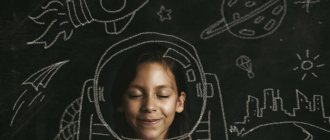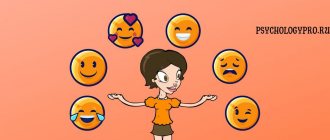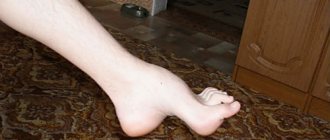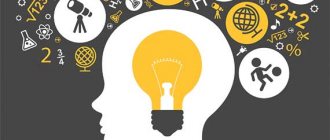Good afternoon, my dear readers!
Today I want to talk about a topic that will not only be educational from a psychological point of view, but also interesting in itself. And I will try to tell you in detail how to develop fantasy and imagination in adults.
In fact, adults need advice in this area more than children. Because children's imagination is much richer and brighter, and their fantasy is much more vivid than that of those who have grown up and already look at the world more rationally.
Perhaps you will say that even without imagination a person can live calmly all his life. I agree with you, but only partly.
At the same time, the ability to fantasize enriches, expands boundaries, adds color to life - in a word, makes it more interesting.
In addition, the absence of these can pose a real problem, or at least an inconvenience. Agree, not all of our daily activities are rational. Sometimes we need to approach them creatively, with imagination.
If suddenly you are one of those who cannot boast of the brightness of the images that arise in your head. If creative tasks drive you into a stupor, this article is for you. So, let's look together for ways to help you.
How to develop imagination and visualization as an adult? Where to start and how to move forward?
“Maria Ivanovna, we urgently need to find a way out of this situation!”
- you hear at work. Or do you come home from work, and your child once again asks to play something interesting? How to use exercises to develop imagination and visualization in an adult in order to become successful and happy? Well, here we are again, twenty-five, but what does success have to do with it? To do this, it is enough to be educated, responsible, and smart. That's how it is. But imagination can give you more.
Everything is very simple. To invent is to create, and creation is always unique. Creative and unique people are difficult to find, much less replace. This is value.
Creativity is possible thanks to the imagination and the right hemisphere. Creative people are needed!
Imagination is:
- creative approach in any field, profession,
- exciting games with children, fun and happiness,
- finding a way out of any difficult situation.
Children cope with the last point very well) Do you want to know what you need to do to restore your imagination? Great! Let's run!
The content of the article:
Proven Formula for Progress
- Ready to test your imagination now?
How to easily develop imagination and visualization in adults?
- How to quickly fill yourself with visual images?
- Revitalizing the right hemisphere
- Simple and useful actions to activate your imagination
- Secret techniques for developing imagination
Where to start developing visualization?
Gulliver's Mystery or how to write fairy tales for children
How it happens
There are several classifications. I will give the most common ones.
According to the degree of purposefulness, the following types of imagination are distinguished: active and passive.
Active stimulates a person to create, allows him to create something new in professional and creative activities. It is divided into:
- Reproductive. It is a recreation of real images based on lived experience.
- Productive (or creative). Images are created according to their own design, almost without recourse to experience.
Passive does not have the goal of realizing invented ideas. It comes in two forms:
- Involuntary. It is an unintentional imagination that can be difficult or impossible to control. This includes random thoughts, dreams, hallucinations.
- Arbitrary. It is controllable and is associated primarily with unlikely or incredible predictions for the future. These are our dreams and dreams.
Proven Formula for Progress
Remember the words of Albert Einstein? He said that knowledge is limited, imagination is more important, since it stimulates progress and gives rise to evolution.
Once upon a time there were no cups, people drank from their hands, folding them into a boat. And someone thought of making a cup like this.
This genius transferred the functions of folded hands into a drinking vessel. And the cups appeared. People began to use cups, and progress occurred. And so it is in everything that surrounds us.
Here: Games that develop fantasy and imagination - 5 important steps You can read in more detail about the concept of imagination and games with children to develop imagination (will open in a new tab).
Imagination develops the brain!
Why are creative people needed everywhere? Of course, of course, because of their ideas, original approach. All this is true.
But the first and most secret thing is that imagination, as the highest mental process, is connected with many other mental processes.
It is associated with thinking and memory. And by developing one, we get results in these processes. At least three in one. Memory and thinking improve, and the brain develops.
By the way, the best result (at least imagination and creativity) comes from the ideal interaction of both hemispheres of the brain.
Why are children geniuses from birth? Because they have up to 3 and this amazing interaction is observed. And those who preserve it are considered geniuses.
To preserve it in your children, play these games with them and read our article (will open in a new tab).
What about adults? To establish such interaction with you, go through and download the exercise here (link will open in a new window). Plus, it powerfully relaxes eyes tired from being stuck on gadgets.
Ready to test your imagination now?
The task is to find the superfluous. Here are three pictures. Fork, knife, plate. What's extra? What will you remove? Read no further for now. Think, reflect. What's the catch?)
We look at pictures, think, thinking is involved, our concepts of meaning are explored. “Yeah, you can remove the plate, after all, it’s a dish, but a fork and knife are still cutlery.”
Yes fine. That’s what they taught us in kindergarten when they prepared us for school. And here your imagination waves you goodbye)
Why? Because we proceed from the learned meanings of objects. Is there another way? Eat.
Let's use our imagination. What are the forks and knives for? They are needed to eat food. We put the food on the plate. Right? Yes. So there's nothing superfluous here?
But, according to the conditions of the task, it is necessary to remove the unnecessary. What is unnecessary here that needs to be removed?
And this is where imagination comes in. You noticed that we began to think hard, imagine pictures, go through options for combining them, combining them into a plot. This is it, our imagination.
It decomposes the image into parts, modifies it, and then connects it. In scientific terms, these mental actions - analysis and synthesis - are tools of thinking. And it is impossible to separate them from each other.
Therefore, imagination is a powerful thought process that develops our brain, and a child’s brain is better than early development centers).
What answer did your imagination give? Write in the comments.
Well, now let's develop our imagination.
Actors' Tips for Developing Imagination
Developing imagination is not an end in itself for an actor and an artist. All exercises and pumping are aimed at developing creative thinking. The general broad development of imagination through theatrical games can be equated to gaining multifaceted life experience and serve as training for associative memory.
There are a whole lot of similar techniques, including systems for professional actors. But whether it’s developing imagination for the stage or everyday life, let’s remember that the best fantasies are positive and bright. And it is you who can make the world around you a little kinder and better today and now!
Competent, beautiful speech, the ability to control oneself and control emotions disarm even the most aggressive individual. Will teach all these skills
children's theater school in Moscow
. Competent, beautiful speech, the ability to control oneself and control emotions disarm even the most aggressive individual. Will teach all these skills
How to easily develop imagination and visualization in adults?
But first, the second most secret. When we imagine, we operate with images. Therefore, the right figurative hemisphere is responsible for imagination. By the way, scientists have conducted research, figurative memory has no boundaries.
And following the words of the French scientist I. Saunière, by developing the right hemisphere, we develop the entire brain. Now it becomes clear why creative people have excellent memory, sharp thinking, and are so valued everywhere.
It's all about how the brain works. It is believed that a person who can constantly and easily “climb” into his right hemisphere when solving problems has exceptional abilities and signs of genius.
You just need to learn how to operate with images.
Why are children geniuses from birth? Because in childhood, both hemispheres are active and work synchronously. They have excellent imagination, the power of images, and intuition.
By strengthening this in them in childhood, we will give them amazing abilities. If you want to find out how to preserve all this in children, then here you go: Makoto Shichida’s Method for Children. How can busy mothers do it anyway? (opens in a new window).
Now let's start restoring our abilities.
How to quickly fill yourself with visual images?
1. As we have learned, images are very important. You need to fill yourself with images.
Look and memorize paintings by artists and just a lot of paintings and reproductions. Look for beautiful pictures on the Internet. Then try to recreate them from memory.
Why beautiful paintings?
Do you care what you have for breakfast? That’s how beautiful and pleasant things are better for the brain. Because nothing passes without a trace, everything is recorded by the brain and remembered, if not consciously, then subconsciously for sure.
You can go to museums and exhibitions. Imagination is the creation of a new unusual thing from what is in memory, from existing experience. Therefore, we get visual experience.
Revitalizing the right hemisphere
2. Smell
We take any smell. Let it be a carnation. Inhale it, soak in its scent. What do you smell, what does it smell like? Describe it. Now, what does it suggest to you? Just describe the images that arise, take a pen and write.
What about the smell of the ice cream you ate as a child? What is he like? What does it smell like that you remember? Go back in time and play around for a bit. What did you want then?
3. Touch
Here you need to prepare. Find different surface materials. Let it be a soft toy with warm, soft wool. Maybe a white bear?
Run your hand over the toy, bring it to your face, and rest your cheek against it.
What do you feel, what does it remind you of, what is it like? What was your favorite toy as a child? Write what images came to you.
4. Taste
What is your favourite dish? Who cooked it for you for the first time? What kind of dish is this? What does it look like? Imagine that it is lying in front of you, but you cannot eat it yet.
This will make your mouth water a little more. You can't hold back any longer. Eat it. But there is no need to lash out like that. Slowly, slowly. After all, this is your favorite dish. What do you feel?
5. Hearing
Here all the music is to help you. You can turn on your favorite works and be carried away on the waves of your imagination. What do you see, what do you feel? Watch and remember while the music plays. Then write down all the images that visited you.
And in this article you can listen to music that develops the brain, provides relaxation and expands memory: How to use music to develop the brain and memory - personal experience. 5 best songs (opens in a new tab).
Simple and useful actions to activate your imagination
6. Reading
Have you read a book recently? Is this fiction? Are there any heroes? Where did the specific action take place? Mentally remember this place, and then transfer it to paper.
Draw the main character in your imagination. Try to transfer this image to paper.
7. Email
If you read a letter from a stranger in your mail. Try to mentally draw his portrait. Think through all the details. What is his face, hair, eyes, mouth, nose like?
And his figure? How does he sit when he writes? And then imagine the process of writing a letter to you.
8. Did they call you?
You answered the call and heard an unfamiliar voice. Who is this man or woman? What kind of voice does this person have? Pleasant, gentle, rough, low, tall? Try to imagine the person in your imagination.
9. See the invisible, hear what is seen
A very effective exercise. Turn on the sound of a movie (you can start with a familiar one) and turn off the picture. Listen and watch the film from memory.
Now we do the opposite. Turn off the sound, turn on the picture. You are showing a silent movie. You watch and guess what the characters are talking about.
Now we do the same with an unfamiliar film.
10. Imagine your future
Describe in detail: what you want to have, where to live, what to do. What do you look like? No need for one time. Let it take a few days. It is important to think through everything thoroughly and imagine it.
Just don’t need reality) Dream like you did in childhood. Let it finally be what you really want.
And if you want to add a little something to it, embellish it, so be it. Congratulations, your right brain is alive. Give him free rein.
Secret techniques for developing imagination
11. Link two unrelated objects
For example, a dog and an iron.
First imagine the dog, then the iron. Place them next to each other, opposite each other. What are they doing? Why can they be together or can't they? Come up with new unexpected connections and combinations.
Using prepositions will help you. Iron on the dog, iron under the dog, behind the dog, dog in the iron.
What comes out of this? Can you make up a story?
12. Zoom in and out
What if your nose or legs got longer? To happen? Up to the size of the house, imagine this picture. Live in this image for a little while. What good things can be done and what will not be very convenient to do?
Where would you buy your clothes? How quickly would you go to work? What else?
If your height decreased. Would you become very small, like a mouse? What happened to you? What if no one noticed this? Remember Gulliver? The same technique was used in this tale.
Now you.
13. What does it look like?
Leonardo da Vinci could see a bizarre and necessary picture and situation in the spots on the wall. He himself called this method ridiculous and trivial. But it is precisely this method that leads our mind to invention.
Look at the clouds. What images do they remind you of, what do they look like? Now look at the entire visible part of the sky. What happens to the images now?
We can select any object, not just clouds. The main thing is that it is not clear, but requires reflection.
14. What is hidden in the picture?
Famous children's drawings. This is when a zigzag is marked on paper, and you need to complete the whole picture from it.
Take a pencil and paper. Place dots and hooks with your eyes closed, and then try to complete them into a clear plot, image, the whole picture.
Or this picture. Can you find 14 horses?
Where to start developing visualization?
Visualization is the ability to imagine, to see an object on the internal screen with eyes closed or open.
How are visualization and imagination related? We can imagine somewhere in our heads, using images, and the ability to clearly see them on the internal screen is visualization.
A special variant of visualization is photographic memory, when the memorization or image of what was seen looks like a photograph. During visualization, images can move, live, and also have other modalities (sound, smell, sensations).
How to learn to visualize, to see images? Japanese professor Makoto Shichida, who has a whole right-hemisphere technique, advises using afterimages to develop the power of images.
This is not the only exercise, but it is the simplest. Read about the technique in our article Makoto Shichida’s Method for Children. How can busy mothers do it anyway? (opens in a new window).
And also in the article How to develop photographic memory quickly (opens in a new window).
We will follow his example.
15. Using afterimages
Take any simple picture. Or draw your own red or blue circle on a white background. Print and look at the picture for 5-10 seconds.
You may need more time, but no longer than 30 seconds. Then close your eyes and observe the afterimage of the picture.
It may appear more than once, but after some time. Repeat this exercise as often as possible.
The goal is to see a red circle like the picture on the mental screen with your eyes closed.
Gulliver's Mystery or how to write fairy tales for children
Oh, they are very easy to compose. We have already learned what technique was used by the author to compose a fairy tale about Gulliver. If you remember fairy tales, it can be seen in many other fairy tales and stories.
You can take it into your piggy bank. But what other secret is there?
The most important thing is to recognize that everything in the world is alive and can live its own life. Not even living things. We must agree that in fairy tales everything is possible.
Once you accept this, everything will change. Let's exercise our imagination and take... a stone.
I will offer an option, and you create your own.
A stone can have its own life, children, wife, etc. Or maybe he is still lonely and looking for a soul mate? And he comes across them as gray pebbles.
And suddenly he saw the one and only one - it was an elegant fragment of granite. It sparkled in the sun. When the pebble passed her in small steps, his heart beat in his chest so that this knock could be heard.
And he decided to invite her for a walk. But suddenly the unexpected happened... What happened?
Our heroes did not meet, but… stood in their way. What happened next? What did our loving pebble do? Who helped him? What obstacles did you have to overcome? How did it all end?
Imagine the pebble, his lover, the whole plot and write it down. But, of course, the ending should be happy)
Games for preschoolers
For this age category, more complex techniques are used, aimed at the creativity of children's imagination and intuition:
- "Magic wand". What animal would a child like to turn into and why if he had a magic wand?
- "Mini-visualization". We close our eyes and imagine an autumn forest, a babbling brook, or something else that will evoke pleasant images.
- Life history of the item. We suggest telling the story of its life on behalf of a thing, for example, a geranium on a windowsill or a broom in the hallway.
- Three words. We come up with three words and ask the child to create a phrase in which these words are connected.
- Tasty - tasteless. Words can be tasty or not so tasty, try the word “candy” or “lemon”; The senior student tells the teacher about his feelings and impressions, memories of this word.










